The Independent’s Local Heroes 2009
Local Heroes 2009
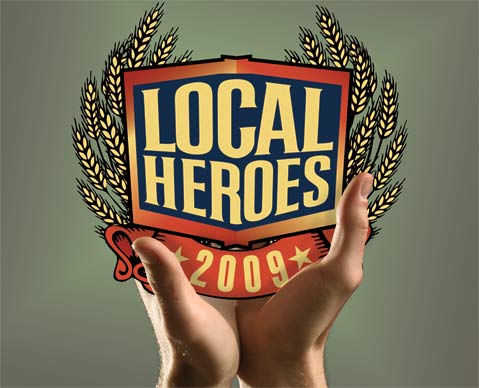
It’s an unhappy land that is in need of heroes, to paraphrase writer Bertolt Brecht. Fortunately, Santa Barbara does not have that problem. In fact, The Indy’s list of Local Hero nominees grows each year; the challenge is in paring it down.
After much deliberation, 20 folks were selected this year based on their inspiring actions. There is the fellow who donated a kidney to his coworker, and the man who gives food, shoes, and other essential items to the homeless, paid from his own pocket. There are folks who are making sure we treat our city-and planet-kindly, those who are bringing people together to help neighbors and animals, and those who provide a unique and essential service to our community.
Each year we are humbled by the giving nature of the group of Local Heroes honored. We take comfort, however, in a line by Will Rogers: “We can’t all be heroes, because somebody has to sit on the curb and clap as they go by.”
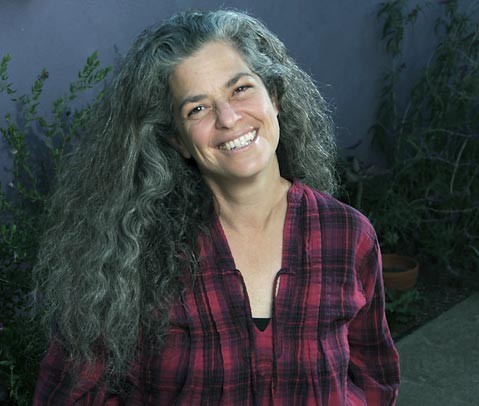
Lynn Seigel-Boettner: Community Gardener
Although more than 20 types of fruits and vegetables surround her home, Lynn Seigel-Boettner isn’t just growing one of Santa Barbara’s coolest front-yard gardens-the longtime teacher is also cultivating a community of harvesters who stay connected under the banner of S.B. Food Not Lawns, the organization and Web site (sbfoodnotlawns.org) that enables garden exchanges from Carpinteria to Goleta. “I encourage people to grow as much as you can and then share what you grow with each other,” said the mother of two, who also helped found Art From Scrap and takes students on bicycle adventures with her husband, John.
Seigel-Boettner began hosting such exchanges-in which people from a particular neighborhood gather on a weekend morning to share the bounties of their gardens with each other, learn about what grows best where, and even do some gardening together-on the Mesa nearly three years ago. Since then more than one dozen regular events, some of them attracting as many as 100 individuals, have gotten started. “I wouldn’t say I started the whole idea,” explained Seigel-Boettner, “but, for the last three years, I have kept the Web site and information up.” By keeping a low profile, empowering others to carry the torch into their own neighborhoods, and then just getting out of the way, Seigel-Boettner’s casual leadership has resulted in Food Not Lawns’ proud sense of group ownership.
“It’s like kindergarten,” said the Vieja Valley School kindergarten teacher, where she’s also started gardens for the kids. “It’s teaching people how to share with each other. It’s an umbrella to invite people to play.”
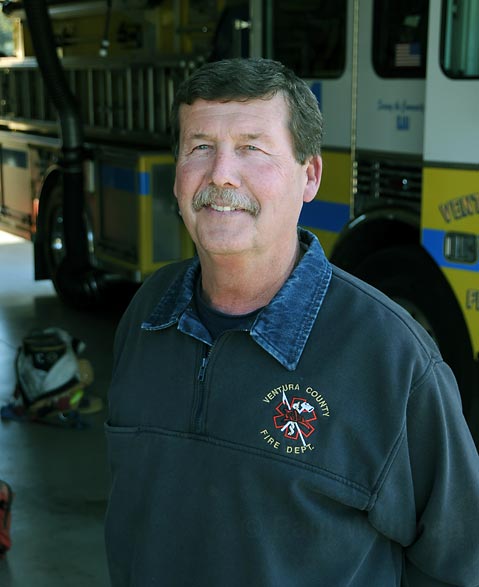
Captain Brian Bulger: The Life-Saving Hero
Given the horrendous conditions of the Jesusita Fire-wind-driven flames attacking clustered communities, narrow roads lined by deep canyons, no escape routes-it’s a miracle that no one died. Well, a miracle, and the work of Captain Brian Bulger, the Ventura County firefighter who risked his own life to pull two colleagues out of the firestorm.
With his crew assigned to Spyglass Ridge, where the fire “burned up canyon and down canyon at the same time,” Bulger, 57, got a call over the radio that some firefighters whom he knew “very well” were taking refuge in a home. Minutes later, “Their voices were pretty elevated,” said Bulger, who’s been a Ventura County firefighter since 1978. “They said they can’t get out of the house and they’re trapped. Things escalated from there.” So he drove into the flames, which were so bright he couldn’t see. “Everything was just fire,” said Bulger, who suffered smoke inhalation injuries that he’s still reeling from.
Wandering through the 100-foot flames and 50 mph winds with visibility at five feet, Bulger stumbled upon firefighter Robert Lopez, 44, and found Captain Ron Topolinski, 51, in a burning fire engine. He saved their lives, and they are both expected back on the job after recovering from their serious burns.
“It’s not something you think about,” said Bulger, who was back on the job within a month. “They had no choices, and I had one. You look at the mission, and you just do it.”
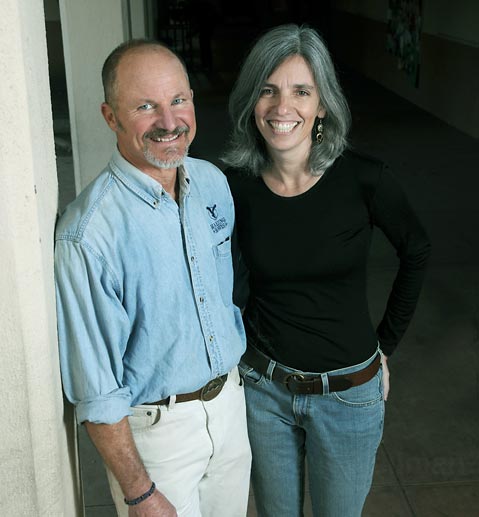
Susan Rakov and Vince Semonsen: School Saints
Susan Rakov and Vince Semonsen always knew they would take an active role in their children’s education. They also liked the idea of walking the kids to school. That meant sending them to Harding Elementary, just five blocks from their lower Westside house.
Six years later, Harding has become a focal point for the entire family. Though Rakov and Semonsen both work, they also volunteer hundreds of hours at Harding every year.
“It’s a public resource,” Rakov explained, noting that many other families in the Harding area sent their children elsewhere. “How do you get a neighborhood which has in large part turned away from the school to come back?”
In order to answer that question, Rakov joined the Harding PTA, but soon recognized the need for a body that could more easily receive major grants. She helped found the Harding School Foundation, which to date has raised more than $100,000 for a new playground and new preschool program. Semonsen chairs the school’s environment committee, which has built an organic garden and commissioned an ambitious master plan.
Since their daughter Emma started at Harding, Rakov and Semonsen have seen the cafeteria become a zero-waste facility and helped reorganize street parking to make pick-ups and drop-offs safer. The school recently launched an International Baccalaureate program and began collaborating with UCSB on educational research. Neighbors now visit the campus every Wednesday to buy fruits and vegetables at the Harding Farmers Market. That’s a lot of change in a short period of time, and Rakov and Semonsen have had a hand in most of it. But Rakov credits the teachers with the real heroics. “The ability of the teachers to put themselves in each child’s shoes makes Harding pretty extraordinary,” she said. “It’s how you’d want a school to be.”
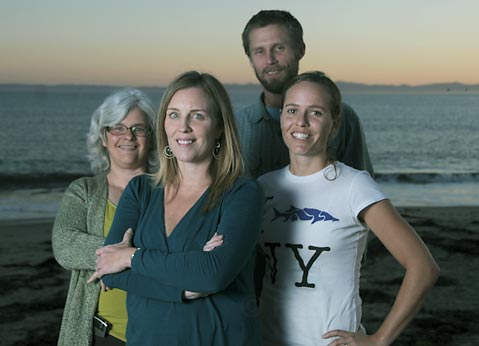
Santa Barbara Channelkeeper: Water Watchers
In a town renowned for its environmental activism, Santa Barbara Channelkeeper (with a little help from the City of Santa Barbara) put itself in a league all its own last year when it started weekly water quality tests at many of the most popular beaches along our coast. When the county was forced to abandon its longtime practice of testing for potential illness-causing bacterial indicators, Channelkeeper saved the day for the thousands of people who surf and swim in Santa Barbara from November through March by immediately picking up the county’s slack. (State law mandates that the county monitor during the “summer” months, but, as most experienced oceangoers know, the biggest need for water quality reports occurs during the rainy or “winter” season.) “When we heard about the county [stopping testing], we really scrambled to step up. It was a huge issue for us, and luckily, we got tons of public support to make it possible,” said Kira Redmond, Channelkeeper’s executive director.
A small grassroots organization, Channelkeeper has been kicking some serious ass on behalf of the ocean here in Santa Barbara since they formed under the umbrella of the Environmental Defense Center more than a decade ago. Besides water quality testing, the crew is responsible for weekly creek testing in both Ventura and Santa Barbara counties, “pollution patrol” in watersheds throughout the South Coast, education programs in area schools (to date, Channelkeeper has taught some 10,000 kids a marine science curriculum), hugely successful eel grass restoration efforts out at the Channel Islands, lobbying county supervisors and the City Council on behalf of watershed-conscious policy, and the current campaign to do away with disposable plastic shopping bags locally. “Pretty much everything we do has a public education component, “said Redmond. “After all, we can’t do this alone.”
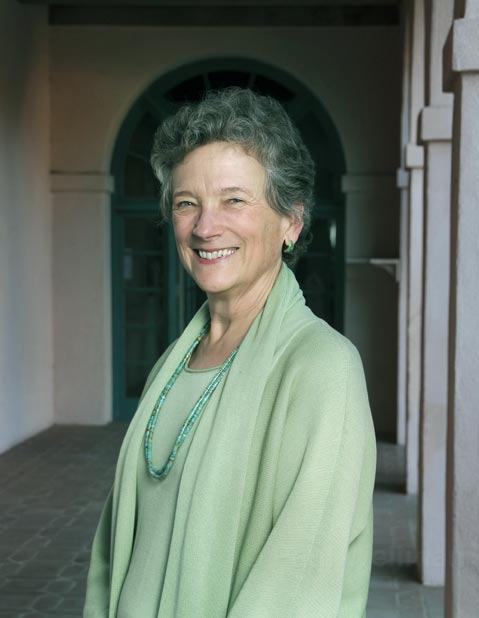
Nancy Bell Coe: Grace Note at the Academy
Looking today at all that’s been accomplished-the construction and opening of Hahn Hall, the artfully managed contributions of such eminent visiting artists as William Bolcom and Christopher Taylor, and the expansion and transformation of the Music Academy of the West’s teaching mission to include a new focus on audience development-it is hard to believe that NancyBell Coe became president of the academy just five years ago. Along with executive experience at the Aspen Music Festival and the Los Angeles Philharmonic, Coe brought with her to Santa Barbara something more than could have been hoped for, even in the most distinguished of leaders-a gift for every kind of deep listening. And that’s what has allowed her to assume the role of genius loci on the bluff in Montecito, and why she will be missed as president when she retires at the end of the 2010 season. Fortunately, Coe won’t be leaving Santa Barbara, and thus we will continue to enjoy her warm presence and lively intellect at all sorts of creative events for many years to come.
In her annual addresses to the incoming group of academy fellows, Coe emphasizes two things about music that she feels go better with saying-that “music is communication,” and requires “acts of kindness and love.” The fact that music is so challenging reminds Coe that the Music Academy’s first obligation is to provide a “safe and supportive” environment where whatever happens, “it’s going to be okay. We want you to succeed.” As the many enthusiastic supporters of the Music Academy will attest, in large part the current quality there is thanks to NancyBell Coe.
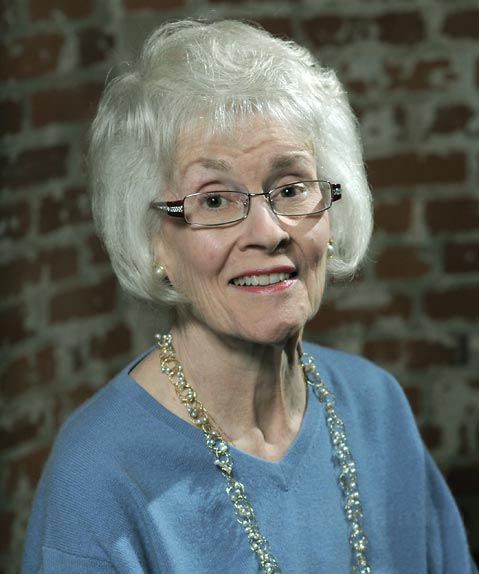
Sara Miller McCune: Philanthropist and Publisher
Sara Miller McCune keeps 40 to 50 books by her bedside and dozens of philanthropies near her heart. Heavens, what if she should waken at 3 a.m. and there’s nothing to read, or a day should dawn and there’s not a new venture to help make the world a better place? When McCune was given a News-Press Lifetime Achievement Award in 2006, she told a shocked audience that she hoped to own the newspaper in a year. During a recent interview, she said, “Do I still want to own the paper? No. I’m not sure I want to own any paper. What I wanted to do, reach a nonacademic audience, is being accomplished with my magazine.” Miller-McCune magazine and Web site, launched last year, enlists journalists in tackling important global subjects.
Her numerous philanthropies include $2.5 million to Santa Barbara Cottage Hospital, more than $5 million toward the Granada Theatre restoration, and $3.5 million to found the SAGE Center for the Study of the Mind at UCSB. Last year she donated $500,000 to establish an endowed social sciences chair at UCSB, dubbed the SAGE Sara Miller McCune Dean of Social Sciences. It’s hard to pick up a program at a Community Arts Music Association or Santa Barbara Symphony concert or Ensemble Theatre play without seeing her name as a sponsor. Somehow she finds time to run SAGE Publications, one of the world’s largest independent academic publishers. She’s part of Social Venture Partners of Santa Barbara, which recently donated to Casa Esperanza homeless shelter, and WillBridge, focusing on homelessness. She believes groups need “time, talent, and treasure. It takes more than money.”
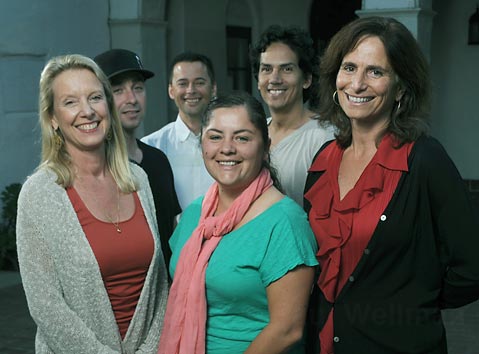
Academy of Healing Arts: Teen Angst Healers
Formed 10 years ago in the wake of the Columbine massacre, the Academy of Healing Arts (AHA) seeks to put the troubled youth of Santa Barbara on a better path by getting them to “say yes to character, compassion, and creative self-expression.” According to cofounders and codirectors Jennifer Freed and Rendy Freedman, AHA has helped about 4,000 young people improve their emotional intelligence and eliminate prejudices through its in-school, after-school, summer, and weekend programs. “Schools don’t teach children how to handle their emotions, especially the destructive ones,” explained Freed, a marriage and family therapist (MFT).
In addition to a high adult-facilitator-to-student ratio (usually around one to six), program director Isis Casta±eda said that teens are drawn to the program’s unique atmosphere, which she described as “confidential, mutual, relaxed, and real.” And the teens do come. “We deal with just about every kind of teen angst you can name,” Freed said. Freedman, also an MFT, noted that the 600 participants currently in AHA programs represent a wider variety of ethnicities and socio-economic classes than one might expect, with all of them interacting with each other and helping each other grow as people and as a community. Like its nonprofit parent organization, the Family Therapy Institute, AHA is fully funded by donations; it has experienced a 40-percent drop in funds this year, but Freed, Freedman, and Casta±eda are still hoping to grow the program even more, enabling them to turn out better-adjusted teens and more capable members of our community.
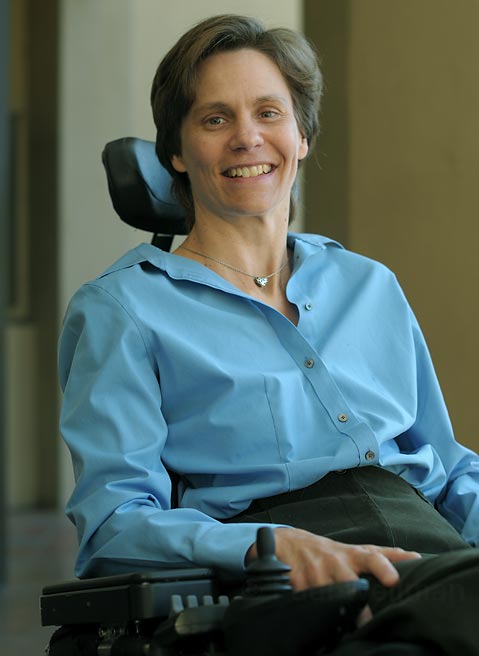
Amy Van Meter: Champion of Accessibility
Though Amy Van Meter’s path to advocacy began during childhood through her mother’s struggles with multiple sclerosis, Van Meter’s life in Santa Barbara has seen her blossom into a powerful ally for Santa Barbarans facing challenges. Van Meter’s own journey with MS began as she moved from the Midwest to Santa Barbara. She has only known life in this city as a person with a disability. “That perspective encouraged me to take up the cause,” she said.
Among the accomplishments Van Meter has helped achieve is restructuring the city’s Access Advisory Committee to effect change-including, for example, ensuring that the downtown public library’s bathrooms are accessible to everyone. “Physical and programmatic access are vital for every member of the community,” she said. “It makes the difference between being able to participate and not.” Van Meter, who just this month was inducted into the National MS Society Volunteer Hall of Fame, is modest about her efforts, stating, “There are lots of people doing good work. I’m not the first one, and I’m not the only one.” She added, “Still, there’s a lot yet to be done : State and federal [laws] are about minimums, and we want to do more than that.”
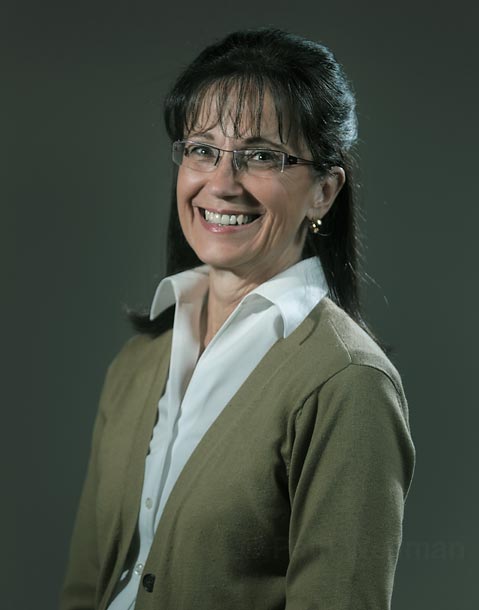
Teri Bontrager: Agricultural Shepherd
There has been no greater kumbaya moment in the past year in Santa Barbara than the announcement last fall of the formation of the Ag Futures Alliance (AFA). A long overdue working partnership betwixt two historically warring factions-the aggies and the enviros-the alliance was made possible thanks to the behind-the-scenes negotiations of several individuals from both sides of the fence. There was perhaps no bigger player in the long stewing process than Teri Bontrager, executive director of the Santa Barbara County Farm Bureau. Bontrager, who has headed up the local Farm Bureau since 2001, but has been an agriculture advocate since 1977 when volunteering at the Garden City, Kansas, Farm Bureau, recently summed up her motivation for helping to forge the Santa Barbara AFA: “Farmers are our original environmentalists. We strive to take care of our land. We [aggies and enviros] all want to keep Santa Barbara Santa Barbara, and I have always been of the belief, ‘Let’s just sit down at the table and talk,’ and that is exactly what we have done.”
While the AFA is a major milestone by any measure, it is by no means the only good to come during Bontrager’s tenure. There is the Agriculture Education Foundation, which provides scholarships and helps get school gardens up and running; the recent work on the new water waiver being hashed out for farmers; and the redoubled vigilance of leafy greens growers and shippers in the wake of last year’s E. coli scare. “Given the varied and often big issues farmers face, it is so important for us to be a part of the decision-making process,” said Bontrager. “But people are busy and it is hard for individuals to speak out on their own behalf : I am honored to be able to help.”
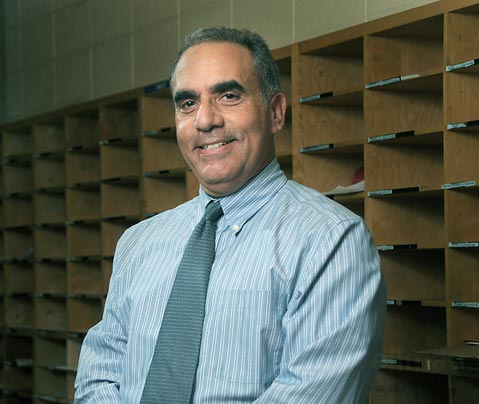
Sergio Castellanos: Guiding Light
The greatest gift,” according to San Marcos High School counselor Sergio Castellanos, “is when a student comes back to see me after they graduate. That’s when I know it’s working.” For 15 years, Castellanos has been dispensing advice, filing recommendations, updating records, leading groups, and often simply listening to the concerns of the approximately 300 high school students that he counsels in an average year. “Just to be there for somebody, and to take the time to listen to them, is often enough to change the outcome of a difficult situation” he said, his eyes shining.
Castellanos has become a local hero through serving the complete range of students at San Marcos, from the underdogs to the top scholars, but what makes him special is the work he does for those who are most vulnerable-at-risk youth and recent immigrants. In the Royals University Club that Castellanos started, undocumented students who qualify for California’s AB540 program are encouraged to apply to the state college and university system. The club expresses a philosophy that Castellanos applies to every student who walks through his door: “You need to know your options.”
Castellanos also runs a weekly support group for students who want to learn how to manage their anger. “I like being named a local hero,” he said, “because every week I say to the students in anger management with me, ‘You are my heroes.’ I tell them that because I know what they are up against. I am aware of the things going on in their lives, and I know that other people have pushed them aside. : We are on a journey together, and what I say as we start out is, ‘It’s okay-I’ll bring you back.'”
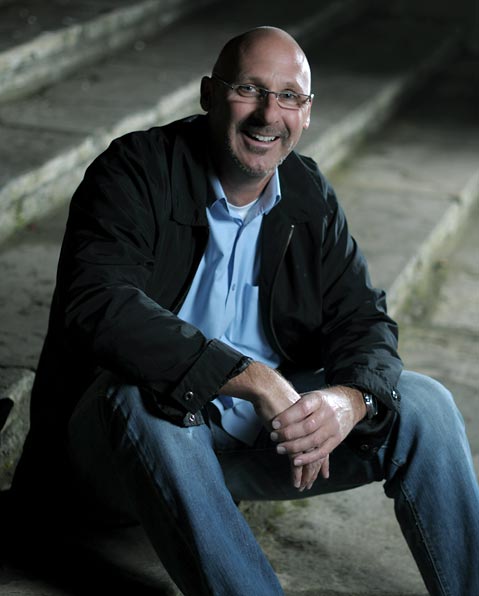
David Selberg: Equal Rights Advocate
David Selberg, executive director of the Pacific Pride Foundation (PPF), has had quite a year. This summer, his organization laid off nearly half of its staff as a result of the budget-slashing in Sacramento. While staffers and volunteers alike scrambled to maintain services for Santa Barbara County’s gay and lesbian communities, as well as those for AIDS-afflicted residents, the group’s October 3 AIDS Walk drew more than 650 participants and generated a record-breaking $110,000-proof that Santa Barbarans of all stripes recognize the necessity of what PPF does. “We’re grateful that so many people in the county have taken ownership of PPF,” Selberg said of the outpouring of support.
Selberg has watched PPF grow since 1989. As public perception of gay people and people with AIDS has changed, so too has PPF, now the largest organization of its kind between San Francisco and Los Angeles. A Santa Barbara native, Selberg is currently working to restore PPF to its prebudget-cut condition, fighting for marriage equality, and pushing for anti-violence legislature. He’s mindful of the good help he has found in Santa Barbara, however. “The reason we stayed open when [organizations like PPF] have closed their doors throughout the state is because supporters, donors, and volunteers have stepped forward and saved us,” he said.
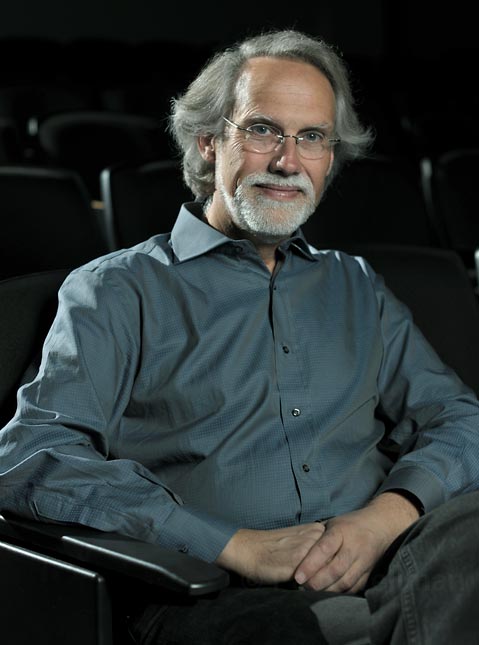
John Blondell: Theatrical Visionary
For 18 years, John Blondell has led the Lit Moon Theatre Company on a worldwide pilgrimage toward fresh theatrical aesthetics and cross-cultural exchange. In addition to producing innovative shows both in Santa Barbara and at theater festivals around the world, Lit Moon has become the sponsor of a series of Shakespeare and world theater festivals that bring to Santa Barbara outstanding examples of physical theater from places as far afield as Belgium, Prague, Finland, and Macedonia. Dozens of European theater artists have made their first trip to the United States thanks to Blondell’s tireless activity on behalf of the global theater community.
Blondell’s creative vision proceeds from a lifelong devotion to expanded notions of the stage that began in his childhood home and came into focus when he did his PhD work on modern directing at UCSB with Simon Williams. An appointment to the faculty at Westmont College in 1988, when he was just 28 years old, gave Blondell the platform he needed to embark on what has become the area’s most far-ranging theatrical odyssey. It’s a journey that has included both his theatrical family-Peter Duda, Stanley Hoffman, and musician Jim Connolly, to name just a few of his longest-standing working relationships-and his talented real family, including wife, actress, and muse Victoria Finlayson and their three sons, Nicholas, William, and Simon. Blondell identifies the communal nature of his enterprise as the core of Lit Moon’s longevity and success, and celebrates the generosity of Westmont College in supporting his work, even when it has been challenging and “countercultural.”
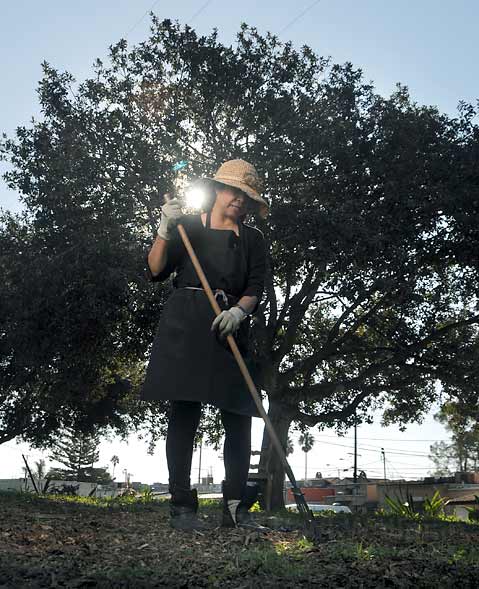
Alice San Andres-Calleja: Herald of the Mesa
Alice San Andres-Calleja calls herself a foot-soldier and a janitor. In reality, she’s a magician who creates community one clump of dirt at a time. She rents an apartment behind Albertson’s on the Mesa, the neighborhood she’s adopted with a vengeance. When she encounters dirty parking lots, she cleans them; when she finds trash in the street, she sweeps it up. When she finds abandoned planter boxes, she plants flower beds. Most recently, she has adopted the vacant lot behind Taco Bell with hopes of converting what’s now a hard-packed gopher colony into 30 neighborhood gardens and a spot for neighborhood talent shows.
Sweet, indefatigable, and indomitable, San Andres-Calleja started The Mesa Paper two years ago, Santa Barbara’s first neighborhood paper, which now goes out to 10,000 households. She also started the monthly Village Hall Meetings, where Mesa residents can come together with the movers and shakers affecting their neighborhoods. This summer, she hosted nine meet-and-greets, potluck events designed to give neighbors a chance to do just that. “On one street, people who’ve been neighbors 40 years shook hands for the first time,” she exclaimed. “That’s what it’s about.”
Calleja joked she’s trying to “raise the serotonin level of the neighborhood,” but it’s more than that. She’s trying to organize the Mesa into “streets teams”-of five houses each-for emergency response. She wants each homeowner to plant a fruit tree in the front yard so all the neighbors can share. When Calleja speaks, ideas pour out of her head, thoughts compete for expression. She’s in a big hurry to get things done. “If you think of something good and beautiful, do it,” she said. “Life is too short to be perfect.”
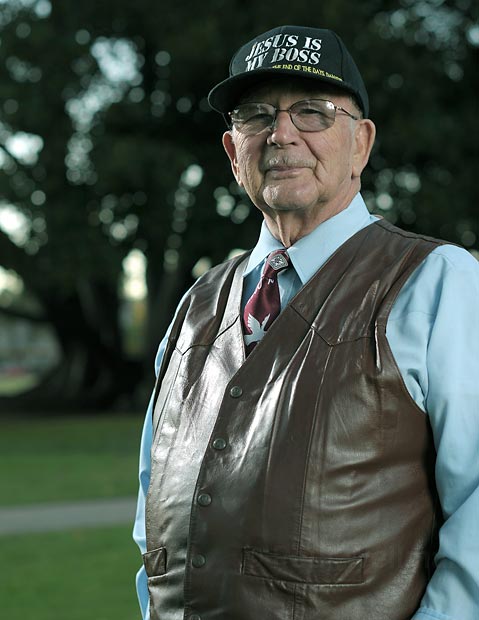
Hank Drost: Feeding the Hungry
Aferocious mystic, and an insurance agent by day, Hank Drost has been feeding the poor and preaching the gospel every Sunday for the past 30 years down by the Por la Mar Park band shell. “The Lord told me which park to use,” he explained. It was the Lord, Drost recounted, who initially instructed him to tend to the poor, telling him to assemble the needy by going out “on the byways and the highways.” Drost recalled his reply at the time, “Lord, I don’t even have a good car.” The car was quickly provided, Drost said, and since then, he has been providing the down-and-out in Santa Barbara with soup, bagels, and coffee, not to mention socks, shoelaces, shoes, razor blades, toothpaste, and toothbrushes.
A one-man philanthropic force, Drost has paid for this out of his pockets with no grants or subsidies. Initially, Drost explained, he felt he could not be involved if passing the hat or collecting money were required to keep the enterprise afloat. Fortunately, the Lord provided, Drost said, by sending him a steady stream of insurance customers over the years. “I always have had love for people on the street,” he said. “And I have a lot of joy in preaching the gospel. ‘I’m hungry and you fed me; I’m naked and you dressed me’-that’s what Jesus did.”
Over the years, Drost, who grew up in Nazi-occupied Holland, has had his run-ins with various government bureaucracies. Each time, the bureaucracies saw fit to retreat. Drost has also encountered complaints that his services discourage poor people from turning their lives around. “I have people who I’ve helped come back and see me. They didn’t have a place to eat or sleep and now they’re running a gas station, now they’re working at Costco or Trader Joe’s,” he said. “It happens all the time.”
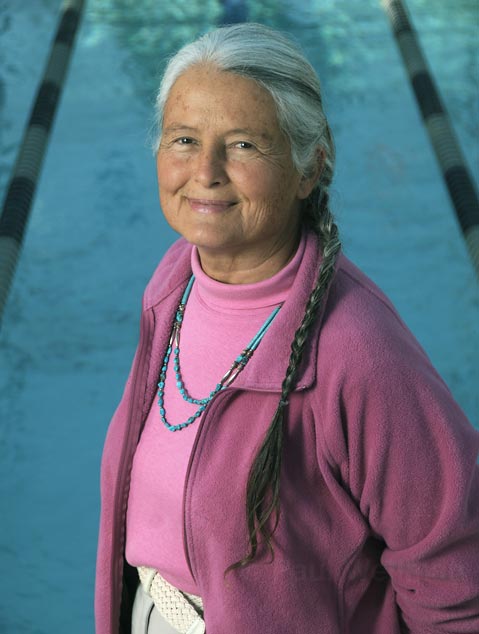
Monica Jones: Noise Maker
Monica Jones didn’t set out to save the free recreational swimming program for kids at the Ortega Pool last summer; it just happened that way. Jones, along with a handful of others, had initially set out to help save the Sunday adult swim program offered at Los Ba±os Pool-where her husband Desmond swims-from city budget cuts. While waiting to testify before the Santa Barbara City Council, Jones, an ardent ocean swimmer, noticed that the Ortega Pool program was also on the chopping block. “This is totally nuts!” she remembers thinking. Ortega was where lots of kids first learned to swim. “These are kids who cannot afford private lessons or the YMCA,” Jones noted. “The fact is, if you can’t swim, it can kill you.”
The daughter of German immigrants, Jones said she knows what it means to grow up without money and speaking a language other than English at home. Before she knew it, Jones had pledged to raise the $9,000 needed to keep the programs at Los Ba±os and Ortega Pool open. In exchange, Jones asked the council to give her enough time to raise the money. It did, and thanks to a mysterious “beautiful mermaid” (whom Jones won’t identify), Chris Edgecomb, and a host of octogenarians who made up the difference with a sprinkling of smaller donations, Jones came through with the cash. “The programs that get cut the fastest are the ones where no one stands up and makes some noise,” she said. Because Jones stood up, about 4,200 people-mostly kids-got to raise a joyful noise while splashing in Ortega Pool last summer.

Isabelle Barense: Dog Guardian Angel
She’s not your typical 11-year-old. From the clothes she chooses to wear to the manner in which she speaks and carries herself, it’s clear that Isabelle Barense is a true individual. She has distinguished herself in her neighborhood-a quiet cluster of suburban homes near Tucker’s Grove Park-by pulling everyone together. At a time when many people don’t know anything about their next-door neighbors, Isabelle-with the help of a neighbor who is a consistent supporter of most things Isabelle does-organized a neighborhood berry festival. Featuring a potluck dinner, a vegetable pi±ata, and entertainment provided by a herpetologist and his menagerie of lizards, snakes, and newts, the event drew close to 50 people.
Aside from uniting her neighbors, Isabelle is a fervent community activist. She recently raised $482 for DAWG, an organization dedicated to finding homes for dogs that might otherwise be euthanized. “I wrote a letter to all my friends and family to tell them what a great organization DAWG is and to ask them to sponsor me to hike to Inspiration Point with [my dog] Tippy and a few friends who wanted to join me,” she said, noting that she has done work for DAWG before. For her eighth birthday party, Isabelle told her friends not to bring presents for her, but to bring things for the dogs.
Isabelle said that her next project will be to raise money to adopt an African hippo, in order to save it from poachers diverted from the now-defunct ivory trade. With aspirations of becoming a botanist focusing on fungi, she has a big future and a lot of things on her to-do list.
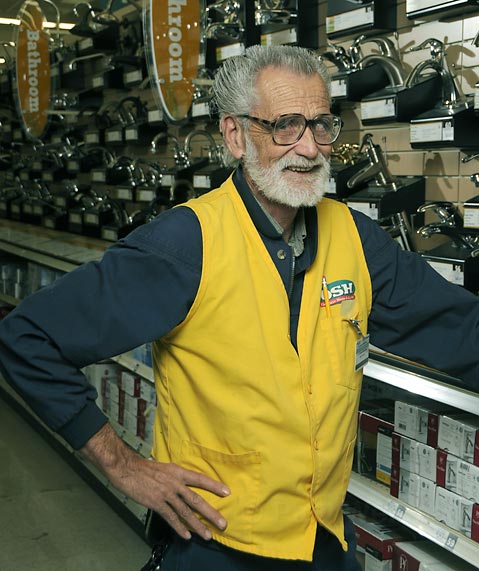
Everett Dobbs: Hardware Guru
One of the worst things about being a do-it-yourselfer is, well, not knowing how to do it yourself. And in this day and age, it’s rare to find anyone walking the aisles of hardware stores wearing a colored vest who really knows what he or she is talking about well enough to help you. Enter Everett Dobbs.
Dobbs is a godsend to do-it-yourselfers, bringing intelligence and wisdom to Goleta’s Orchard Supply Hardware.
Things have changed drastically since Dobbs first began stocking shelves in a Tujunga hardware store in 1956. In those days, community hardware stores were the norm, not the big-box stores employing cheap labor that abound today. Dobbs has been in Santa Barbara since the late ’60s, first working at Builders Emporium, until it shut down a decade later. After a couple of odd jobs, he began working at Holiday Hardware on La Cumbre, before that ownership sold. For the last 10 years, he has been roaming the plumbing aisles of OSH, where you can still find the 68-year-old Sunday through Tuesday.
Dobbs has helped save hundreds, if not thousands, of people from the frustration of figuring out a home project all by themselves, and from the maddening experience of attempting to solicit information from a clueless shelf-stocker manning the floor. Yet his philosophy as a rare godsend to helpless do-it-yourselfers is pretty simple: “I know what this stuff is and what it’s supposed to do,” he said. “I tell them this is how you should do it and this is how you should not do it.”
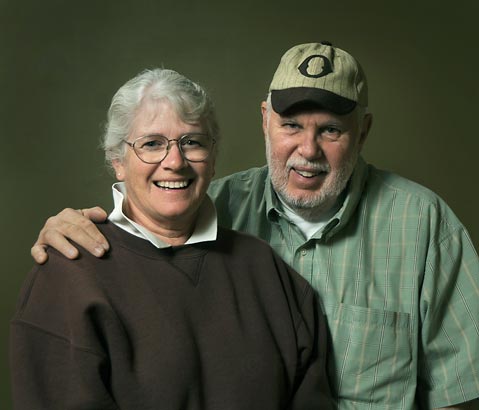
Dave and Louise Moore: Carpinteria Saviors
To describe Dave and Louise Moore as busy would be an understatement. She’s a retired office manager and he’s a retired teacher, but the pair-
college sweethearts who met at Chico State-have kicked their volunteer activities into overdrive to make sure Carpinteria continues to be one of the best beach towns in the world. “Anything you do to give back to the community is outstanding,” said Louise, whose long list of volunteer activities includes serving as treasurer for a number of charitable organizations, as well as collecting shoes and Christmas gifts for struggling families through one of the many church groups with which she’s involved.
Dave’s career, which was spent teaching troubled youth in Oxnard-the program he developed over the better part of 30 years now serves as a model for teachers working under similar circumstances-has morphed into helping out his community. “One of the things that’s on our minds now is the Paredon Project,” he said of the slant oil drilling proposal now hovering over Carpinteria. “We live in one of the most beautiful places in the world, and this could really change the community.” Dave and Louise have also been active campaigners for the preservation of the Carpinteria Bluffs, as well as for the Dahlia Court Project, a refurbished apartment complex designed to provide affordable housing for low-income families.
In addition to all of that, they have two grown children and four grandkids-reason enough for their forward-thinking approach to their community. Said Dave, “We just really want to keep the place nice for everyone.”
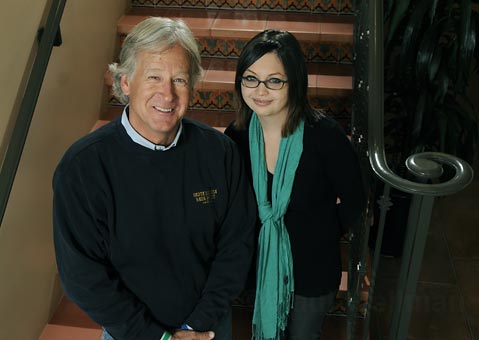
Randy Weiss: Organ Donor
It was a chance encounter that turned into so much more. One Friday afternoon earlier this year, Randy Weiss, vice president of community relations for Santa Barbara Bank & Trust, happened to walk by Katherine Pinedo, a senior teller at the bank’s main branch. Weiss, one of the most forthcoming personalities you’ll come across (think fist bumps with everyone he sees), asked Pinedo how her day was. “It would only be better if I had a kidney,” she responded, an uncharacteristic reply from her normal self.
Pinedo has been living with lupus, a disease that goes after the body’s immune system, since she was six. The disease eventually invaded her kidneys, and shut them down in recent years, forcing Pinedo to undergo dialysis treatments most every day. She also added herself to the organ donor recipient list.
But her answer to Weiss’s question that day quickly put an end to her need for an organ transplant. “It was an easy decision,” said Weiss, who immediately offered his, and within days went to get tested. He never doubted they’d be a match, and they were.
The surgery took place on a Friday, June 12, 2009. Weiss was back to work by Tuesday. The recovery period was longer for Pinedo-she was out until September-but she, too, is now back to full strength and with a brand new kidney. “She’s the real hero,” said Weiss, who said he hoped their story would break down perceived walls on being a donor. “She’s gotten through it and has hope and has prospered.”
And while Pinedo now has Weiss’s kidney, he thinks he got the better end of the deal. “I got a new sister,” he said.
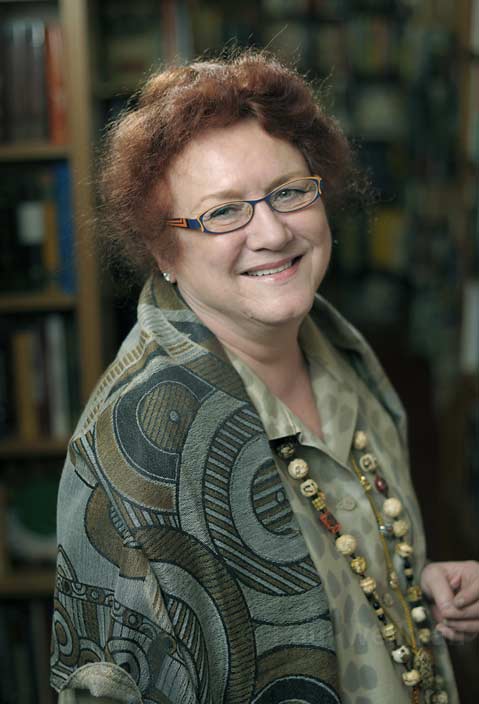
Mahri Kerley: Queen of Books
Thirty-five years ago, avid reader Mahri Kerley was sad to hear that her favorite bookstore was closing. So, despite having no business experience, she decided to buy it, and, in 1974, settled into an 800-square-foot space in Five Points. Chaucer’s Books was born.
Relying on her book sense, Kerley kept her fledgling shop afloat and even expanded it, moving to Loreto Plaza in 1983. With books tidily stacked on the floor and in the shelves and every cranny available, Kerley offers an astounding array of topics and titles. With subject subheadings noted by pieces of cardboard jutting from the stacks, everything from cookbooks to politics to spirituality to westerns to mysteries await browsers and readers. There is also an extensive children’s section with all the reading material kids-and parents-could want. The inventory is made all the more impressive by the depth of subject matter. For example, not only is there a section on terrorism, there is a sub-category called “Troublemakers.” In fact, there are 369 sections to pursue.
A treasure trove for word-loving Santa Barbarans, Chaucer’s is also a vital part of our community. Each year the store holds book fairs for S.B. schools. “Our fairs raised well over $15,000 this year,” Kerley said. In addition to helping our young folk, the store hosts a plethora of author readings and signings. As a result, Kerley has garnered generations of loyal customers.
With big-box bookstores gobbling up the marketplace, Chaucer’s is one of only a handful of independent booksellers left. As Kerley put it, “The world is getting more people and less choice.” The store’s secret to success? An incredibly knowledgeable staff, including many who’ve been working there for more than a decade; a cozy, intimate atmosphere that begs getting lost in the stacks while trolling for a book; and a commitment to engaging readers of every ilk with fantastic books.



